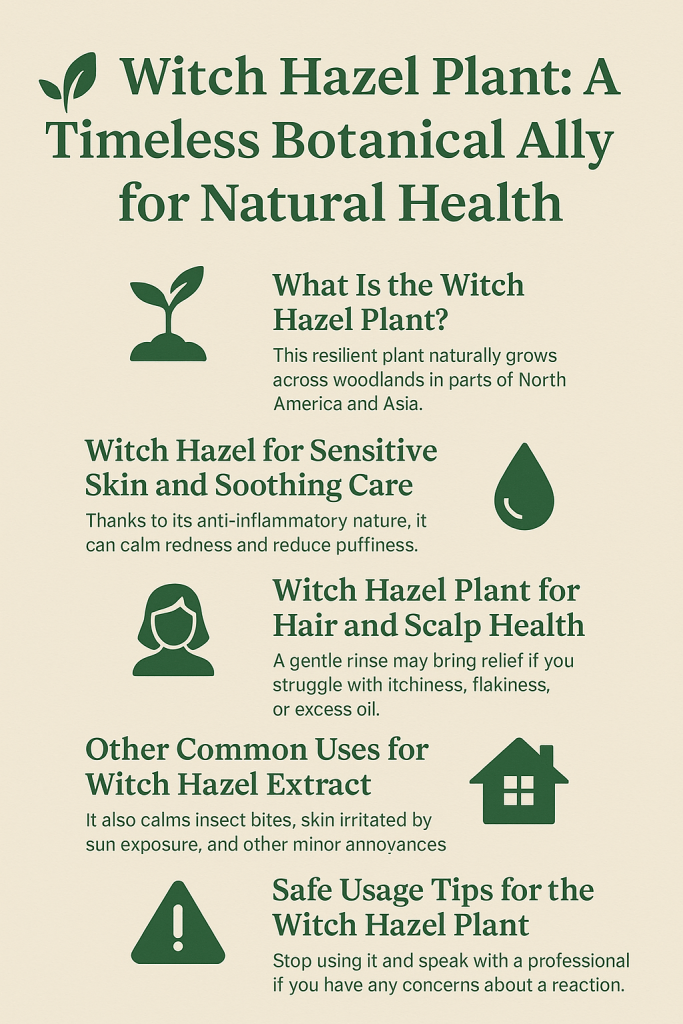🌿 Witch Hazel Plant: A Timeless Botanical Ally for Natural Health
The witch hazel plant has become well-known for its impressive soothing properties and its long-standing role in natural wellness.
People often turn to it because it supports the skin’s natural balance while helping with tone, irritation, and inflammation. While many know it for its skincare perks, there’s plenty more beneath the surface.
We’re going to explore where it comes from, the ways people have traditionally used it, and why it remains so useful in modern natural health routines.
🌱 What Is the Witch Hazel Plant?
This resilient plant naturally grows across woodlands in parts of North America and stretches into areas of Asia as well.
It thrives best in cooler zones and tends to favour moist, shaded environments like forest floors, creek banks, and thickets.
Despite its delicate yellow flowers that bloom in autumn, this plant is far tougher than it appears and adapts easily to harsh weather conditions.
The bark and leaves are rich in natural compounds that make it so useful. Tannins help tone the skin, while antioxidants assist in maintaining its health and clarity.
For centuries, Indigenous communities used it in soothing infusions to reduce inflammation and help minor skin troubles heal.
Even in modern times, it remains a common ingredient in skincare—often featured in toners, spot treatments, and soothing gels because of its gentle, purifying effects.
Thanks to its many helpful uses, this herbal staple has earned a place in homes across different cultures and climates.
Whether you’re soothing irritated skin or easing an itchy scalp, this plant continues to prove its value.
💧 Witch Hazel for Sensitive Skin and Soothing Care
If your skin is easily irritated, the witch hazel plant might become your new best friend. Thanks to its anti-inflammatory nature, it can calm redness and reduce puffiness. Moreover, it tightens the skin slightly, helping to minimise the appearance of pores.
Those with acne-prone skin may notice improvements with consistent use. That’s because the plant helps to cleanse the skin and reduce excess oil. However, it’s always a good idea to do a patch test first—especially if you have dry or sensitive skin.
Besides acne, many people use it for shaving cuts or razor burn. Its gentle astringent action closes up minor nicks while easing inflammation. So instead of stinging alcohol-based toners, you’re using something nature made.
🧴 Soothe Redness with Witch Hazel’s Natural Properties
The witch hazel plant works well as a toner, balancing oil without stripping moisture. For this reason, it’s ideal for daily use. Simply dab some on a cotton pad and swipe gently across your skin after cleansing. Another good soother of the skin is. Banana leaves.
Although it’s a powerful natural solution, using too much might dry the skin. Therefore, it’s best to start slowly and see how your skin reacts. Many people rotate it with a moisturising toner to strike the right balance.
💆♀️ Witch Hazel for Hair and Scalp Health
Did you know this woodland wonder can work wonders for your scalp too? If you struggle with itchiness, flakiness, or excess oil, a gentle rinse can bring relief. The tannins in witch hazel help reduce inflammation while supporting healthy circulation.
To apply it, simply mix a few drops of witch hazel extract into a cup of warm water. Massage it gently onto your scalp before rinsing. Many users notice reduced itchiness within days. Furthermore, it won’t leave your hair greasy or weighed down.
Because it’s natural, this remedy makes a great alternative to harsher chemical-based treatments. And since it helps balance oil levels, it’s particularly good for those with oily roots.
🧼 Herbal Scalp Rinse
Making your own rinse is simple and budget-friendly. First, choose a pure, alcohol-free witch hazel extract. Next, combine one part extract with three parts water. Pour it onto the scalp, let it sit for a few minutes, then rinse thoroughly.
You can use this mix once or twice a week. It’s especially helpful during the warmer months when sweat and oil build up quickly. Just avoid applying it to broken skin or open wounds.
Here is another post on the benefits of bay leaves.
🏠 Other Common Uses for Witch Hazel Extract
Beyond skincare and scalp care, the witch hazel plant serves many other purposes. It calms insect bites, minor burns, and skin irritated by sun exposure. Some people even create an after-sun spray by diluting the extract with water.
Others turn to it as a natural deodorant. Its antibacterial nature helps manage odour without blocking pores. For those avoiding aluminium or artificial fragrances, it offers a gentle alternative.
It may also help reduce the appearance of varicose veins. When applied topically, it supports circulation and eases inflammation. However, this benefit needs further research for confirmation.
⚠️ Safe Usage Tips
Although the witch hazel plant is gentle, using it wisely still matters. Always check the label if you’re buying a commercial extract. Some versions contain alcohol, which may dry out the skin if used too frequently.
When preparing your own infusion, make sure to strain it well. A poorly filtered liquid might contain small particles that irritate the skin. Also, keep the extract away from eyes and avoid using it on open wounds.
Stop using it if you notice irritation, and speak with a professional if unsure. While reactions are rare, they can happen. As with most herbal remedies, starting small is the safest approach.
🔬 Research-Backed Benefits of Witch Hazel
Scientific studies back many traditional claims about this plant. For example, research shows that witch hazel has antioxidant, antimicrobial, and anti-inflammatory effects. These properties make it valuable for wound healing, skin protection, and inflammation reduction.
Moreover, dermatologists often recommend it for people with mild skin irritation. Because of its gentle action, it doesn’t cause the same harsh reactions as some synthetic ingredients.
Still, not all benefits are proven yet. Some popular uses—like reducing haemorrhoid symptoms or treating cold sores—are supported more by tradition than science. However, more studies are underway.
📝 Final Thoughts on Witch Hazel
The witch hazel plant offers a beautiful blend of nature and science. From treating acne to soothing bug bites, it’s stood the test of time. It’s gentle, affordable, and easy to find in most health stores.
Whether you’re new to herbal remedies or looking to replace chemical products, this is one worth considering. Just remember to check the ingredients, use it sparingly at first, and see how your body responds.
Here are a couple of articles you might find helpful:
Let nature do what it does best—support, soothe, and restore.






